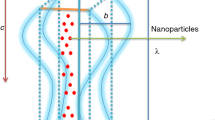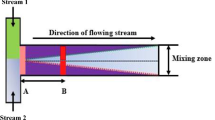Abstract
The microfluidics of controlled nanodrug delivery to living cells in a representative, partially heated microchannel was analyzed, using a validated computer model. The objective was to achieve uniform nanoparticle exit concentrations at a minimum microchannel length with the aid of simple static mixers, e.g., a multi-baffle-slit or perforated injection micro-mixer. A variable wall heat flux, which influences the local nanofluid properties and carrier-fluid velocities, was added to ensure that mixture delivery to the living cells occurred at the required (body) temperature of 37°C. The results show that both the baffle-slit micro-mixer and the perforated injection micro-mixer aid in decreasing the microchannel length while achieving uniform nanoparticle exit concentrations. The injection micro-mixer not only decreases best the system’s dimension, but also reduces the system power requirement. The baffle-slit micro-mixer also decreases the microchannel length; however, it may add to the power requirement. The imposed wall heat flux aids in enhanced nanoparticle and base-fluid mixing as well.







Similar content being viewed by others
References
Brotherton CM, Sun AC, Davis RH (2008) Computational modeling and comparison of three co-laminar microfluidic mixing techniques. Microfluid Nanofluid 5:43–53
Chang C-C, Yang R-J (2007) Electrokinetic mixing in microfluidic systems. Microfluid Nanofluid 3:501–525
Chung CK, Shih TR (2008) Effect of geometry on fluid mixing of rhombic micromixers. Microfluid Nanofluid 4:419–425
Floyd-Smith TM, Golden JP, Howell PB, Ligler FS (2006) Characterization of passive microfluidic mixers using soft lithography. Microfluid Nanofluid 2:180–183
Hardt S, Drese KS, Hessel V, Schonfeld F (2005) Passive micromixers for applications in the microreator and μTAS fields. Microfluid Nanofluid 1:108–118
Kang TG, Singh MK, Kwon TH, Anderson PD (2008) Chaotic mixing using periodic and aperiodic sequences of mixing protocols in a micromixer. Microfluid Nanofluid 4:589–599
Kim DS (2004) A barrier embedded chaotic micromixer. J Micromech Microeng 14:798–805
Kleinstreuer C (2006) Biofluid Dynamics—principles and selected applications. Taylor & Francis, Boca Raton
Kleinstreuer C, Li J (2008a) Microscale Cooling Devices. In: Li D (ed) Encyclopedia of micro and nanofluidics. Springer, Heidelberg
Kleinstreuer C, Li J (2008b) Discussion: effects of various parameters on nanofluid thermal conductivity. ASME J Heat Transfer 130:025501-1-3
Kleinstreuer C, Li J, Koo J (2008) Microfluidics of nanodrug delivery. Int J Heat Mass Transf (in press)
Koo J, Kleinstreuer C (2003) Liquid flow in microchannels: experimental observations and computational analysis of microfluidics effect. J Micromech Microeng 13:568–579
Labhasetwar V, Leslie-Pelecky DL (2007) Biomedical applications of nanotechnology. Wiley-Interscience, Hoboken, NJ
Li J (2009) Computational analysis of nanofluid flow in microchannels with applications to micro-heat sinks and bio-MEMS. PhD dissertation, MAE Department, NCSU, Raleigh
Maxwell JC (1904) A treatise on electricity and magnetism, 2nd edn. Oxford University Press, Cambridge
Munson MS, Yager P (2004) Simple quantitative optical method for monitoring the extent of mixing applied to a novel microfluidic mixer. Analytica Chimical Acta 507:63–71
Nguyen N-T (2008) Micromixers: fundamentals, design and fabrication. William Andrew, Norwich
Nguyen N-T, Wu Z (2005) Micromixers—a review. J Micromech Microeng 15:R1–R16
Saliterman SS (2006) Fundamentals of BioMEMS and medical microdevices. Wiley-interscience, SPIE Press, Bellingham, Washington, US
Stroock AD et al (2002) Chaotic mixer for microchannels. Science 295:647–651
Thakur RK, Vial CH, Nigam KDP, Nauman EB, Djelveh G (2003) Static mixers in the process industries—a review. Chem Eng Res Des 81:787–826
Xuan Y, Roetzel W (2000) Conceptions for heat transfer correlation of nanofluids. Int J Heat Mass Transf 43:3701–3707
Acknowledgments
The generous endowment of the McDonald-Kleinstreuer Fellowship provided by Dr. J.P. Archie, Jr. and his wife Sarah, presently supporting Jie Li, as well as the use of ANSYS-CFX11 (Ansys, Inc., Canonsburg, PA) are gratefully acknowledged.
Author information
Authors and Affiliations
Corresponding author
Rights and permissions
About this article
Cite this article
Li, J., Kleinstreuer, C. Microfluidics analysis of nanoparticle mixing in a microchannel system. Microfluid Nanofluid 6, 661–668 (2009). https://doi.org/10.1007/s10404-008-0341-1
Received:
Accepted:
Published:
Issue Date:
DOI: https://doi.org/10.1007/s10404-008-0341-1




